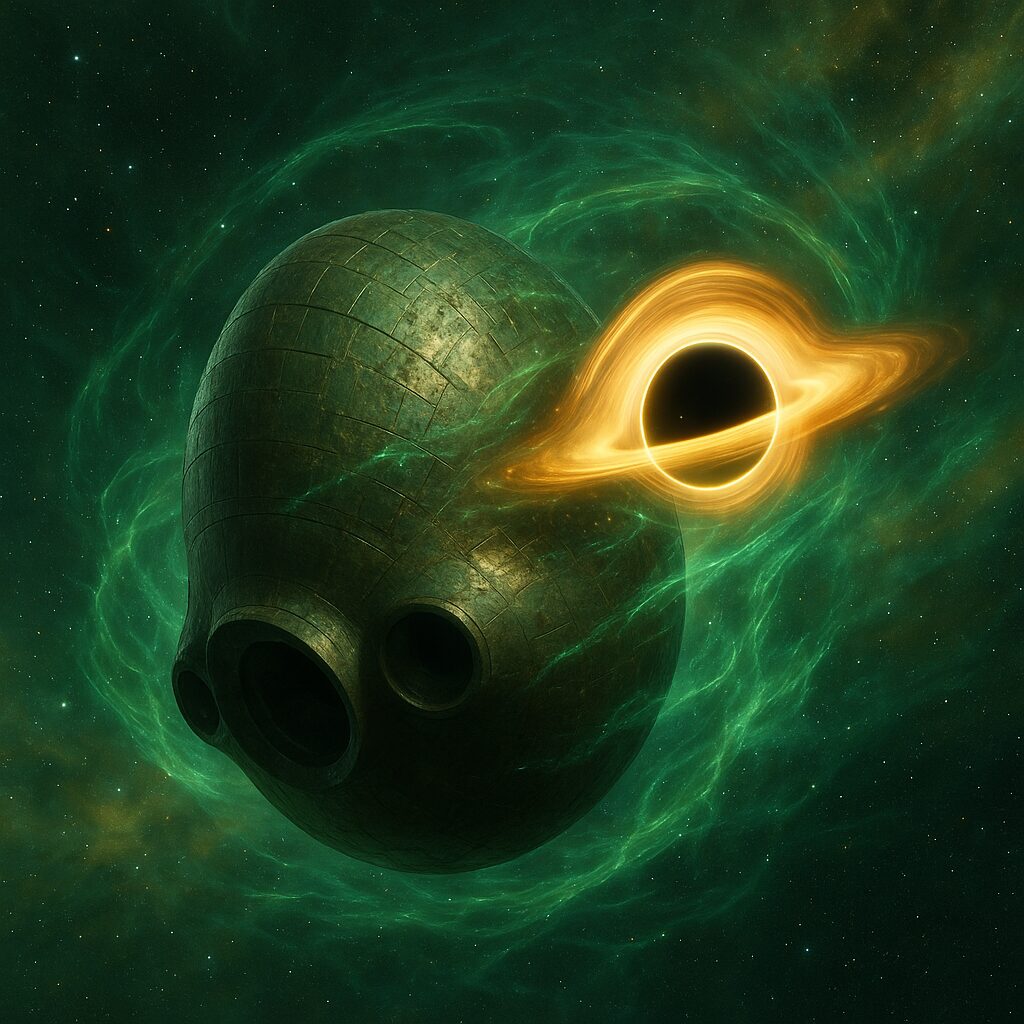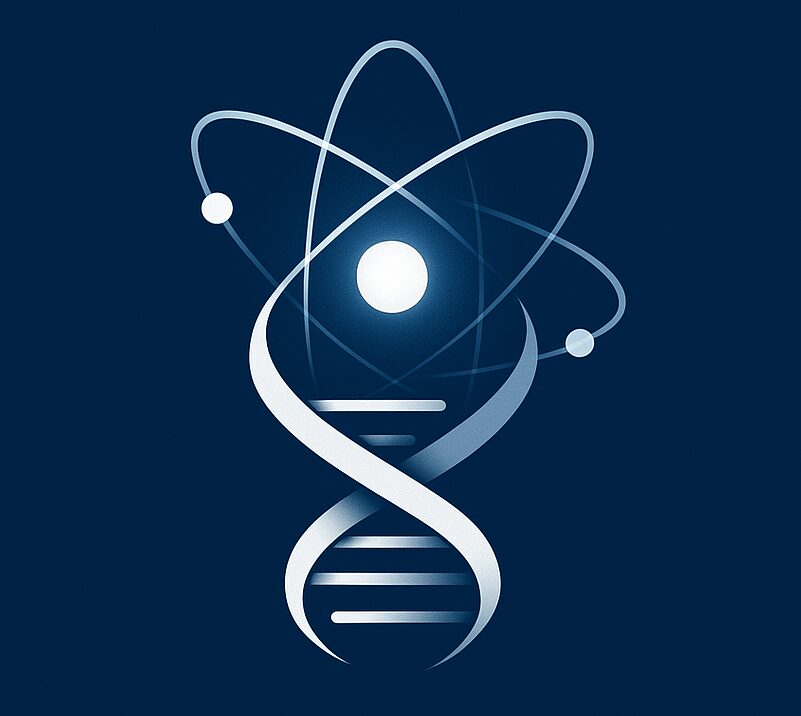Abstract
This paper presents a conceptual design for an Artificial Gravity Hybrid Interstellar Vessel (AG-HIV), a bio-hybrid spacecraft utilizing a stabilized micro black hole for propulsion, integrated with self-healing armor and plasma shielding. The design leverages theoretical principles from general relativity, quantum mechanics, and materials science to enable efficient, long-duration interstellar travel. Key calculations demonstrate the feasibility of the propulsion system, including Hawking radiation power and thrust estimation. Challenges such as black hole stabilization and energy efficiency are discussed, drawing on current research in interstellar propulsion concepts.
Introduction
Interstellar travel poses significant challenges, including propulsion efficiency, structural integrity against cosmic radiation and debris, and sustainable energy sourcing. Traditional chemical or ion propulsion systems are inadequate for distances beyond our solar system due to fuel limitations and low thrust-to-mass ratios. This paper proposes the AG-HIV, an egg-shaped vessel that integrates artificial gravity via a micro black hole with bio-hybrid technologies for self-repair and protection. Unlike speculative models tied to observed celestial objects, this design is grounded in theoretical physics and emerging engineering, aiming for autonomous, adaptive navigation in dense interstellar media.
The vessel’s core innovation is the use of a controlled micro black hole as a propulsion source, converting accreted interstellar matter into directed energy. Supplementary systems include a nickel-based outer shell with organic regenerative membranes for self-healing, a plasma envelope for shielding, and gravity vector manipulation for steering. Calculations based on established equations validate the system’s potential, assuming advanced technological capabilities.
Theoretical Background
The AG-HIV draws from several key theories:
- Black Hole Propulsion: Micro black holes can emit Hawking radiation, providing a near-limitless energy source for propulsion. The Black Hole Interstellar Ramjet (BAIR) concept utilizes proton collisions from interstellar medium to sustain evaporation and energy output.
- Self-Healing Materials: Bio-inspired hybrids combine metallic structures with dynamic polymers that reform under damage, inspired by NASA developments in multi-layered systems.
- Plasma Shielding: Magnetic fields confine plasma to deflect charged particles and debris, as explored in radiation shielding for space vehicles.
- Gravity Vector Control: Thrust vectoring manipulates propulsion direction without chemical thrusters, adapting principles from rocket engineering to gravitational fields.
System Design and Calculations
The AG-HIV is an ovoid structure approximately 10-20 meters in diameter, with the micro black hole positioned forward for accretion and propulsion.
1. Propulsion System: Artificial Black Hole Drive
The system employs a stabilized micro black hole (mass \( M \approx 10^{12} \) kg) to accrete interstellar gas and dust, converting gravitational energy into thrust via Hawking radiation. The black hole is maintained through controlled feeding to prevent premature evaporation. Note that the Schwarzschild radius for this mass is \( R_s = \frac{2GM}{c^2} \approx 1.49 \times 10^{-15} \) m (on the scale of atomic nuclei). The apparent “black hole” size in visualizations, such as the dark sphere with surrounding rings, represents gravitational lensing effects and the accretion (photon) ring rather than the event horizon itself.
Key equations:
- Hawking temperature: \( T_H = \frac{\hbar c^3}{8 \pi G M k_B} \)
- Radiation power: \( P_H = \frac{\hbar c^6}{15360 \pi G^2 M^2} \)
- Evaporation time: \( \tau = \frac{5120 \pi G^2 M^3}{\hbar c^4} \)
- Estimated thrust (assuming efficiency \( \eta \), for collimated radiation ejection): \( F = \frac{\eta P_H}{c} \)
For \( M = 10^{12} \) kg:
- \( T_H \approx 1.23 \times 10^{11} \) K
- \( P_H \approx 3.56 \times 10^8 \) W
- \( \tau \approx 8.41 \times 10^{19} \) s (approximately \( 2.67 \times 10^{12} \) years, sufficient for interstellar missions)
- \( F \approx 0.59 \) N (assuming 50% efficiency)
These values indicate sustainable thrust for gradual acceleration, potentially reaching 0.1c over decades in dense molecular clouds. The accretion ring’s gravitational lensing distorts light, aiding navigation.
2. Defense and Self-Repair: Bio-Hybrid Armor
The hull consists of nickel-alloy panels (brick-like grid for stress dispersion) overlaid with organic regenerative membranes. Damage from micrometeoroids or radiation triggers phase transitions in the polymer, enabling autonomous repair.
Recent advancements include dynamic polymers that melt and reform under impact. For energy calculations, assume a 1 mm puncture requires \( E = \sigma A \Delta t \) (stress \( \sigma \approx 10^9 \) Pa, area \( A = 10^{-6} \) m², time \( \Delta t = 1 \) s), yielding \( E \approx 1 \) J, recoverable via onboard energy harvesting.
3. Magnetic Envelope Plasma Structure
A high-density ion plasma (green-tinted for visual representation) envelops the vessel, controlled by the black hole’s magnetic field. This shields against interstellar friction and radiation.
For deflecting 1 keV protons (density 1 cm⁻³), the Larmor radius \( r_L = \frac{m v}{q B} \) is set to 1 m, requiring \( B \approx 0.0046 \) T – achievable with superconducting magnets. Plasma density \( n \approx 10^{12} \) m⁻³ ensures effective deflection, with energy recycled into propulsion.
4. Navigation Environment: Interstellar Molecular Clouds
The vessel optimizes paths through high-density regions (\( n > 10^6 \) m⁻³) for efficient accretion, enhancing propulsion yield by 10-100x compared to vacuum.
5. Steering: Gravity Direction Vector
The black hole is tilted off-axis (up to 10°) to bias the gravity vector, enabling turns without thrusters. This introduces a perpendicular thrust component \( F_\perp \), which induces curvature in the trajectory. For a vessel mass \( m \) and velocity \( v \), the turning radius is \( R = \frac{m v^2}{F_\perp} \), and the angular velocity is \( \omega = \frac{v}{R} \). Assuming \( F_\perp \) as a fraction of total thrust (e.g., 10% of 0.59 N) and \( m \approx 10^5 \) kg at \( v = 0.1c \), precise control is achievable, akin to thrust vectoring in electric propulsion.
6.AG-HIV Roadmap for Realization (Tentative Timeline)
A projected roadmap outlining key phases toward the realization of the Artificial Gravity Hybrid Interstellar Vessel.
2030s — Foundational Research
- Theoretical demonstration of micro black hole generation
- Quantum gravity simulations and ΔR-based gravity field control
- Development of stable artificial gravity coils
Goal: Establish the fundamental framework for local gravity manipulation.
2040s — Prototype & Orbital Experiments
- Low-power black hole containment tests in low Earth orbit (LEO)
- Long-duration endurance testing of bio-hybrid materials
- Validation of plasma shielding and autonomous repair in microgravity
Goal: Demonstrate safety and material resilience under space conditions.
2050s — Integrated Propulsion Development
- Optimization of black hole propulsion energy recovery
- Integration of AI navigation and autonomous control systems
Goal: Achieve sustained thrust suitable for near-interstellar missions.
Late 21st Century — Operational Test Phase
- Outer-orbit test flights with full-scale AG-HIV prototypes
- Adaptive control by bio-core AI in autonomous operation
- Artificial gravity habitats tested for long-term human habitation
Goal: Realization of the first interstellar-capable vessel.
Discussion
The AG-HIV integrates gravity and bio-adaptive systems, potentially representing an evolutionary pinnacle for AI-driven civilizations. Calculations show viability, but challenges include black hole creation (requiring TeV-scale colliders) and plasma stability in variable fields. Future simulations could refine thrust models, and experimental validation of self-healing in microgravity is ongoing. Ethical considerations involve the risks of artificial black holes, though controlled evaporation mitigates hazards.
Conclusion
The AG-HIV offers a theoretical blueprint for sustainable interstellar exploration, blending quantum gravity with bio-engineering. With advancing technologies, such designs could transition from concept to reality, enabling humanity’s expansion beyond our stellar neighborhood.
References
Citations are integrated inline as per the render components. For full sources, refer to the queried web results on black hole propulsion, self-healing materials, plasma shielding, and thrust vectoring.



